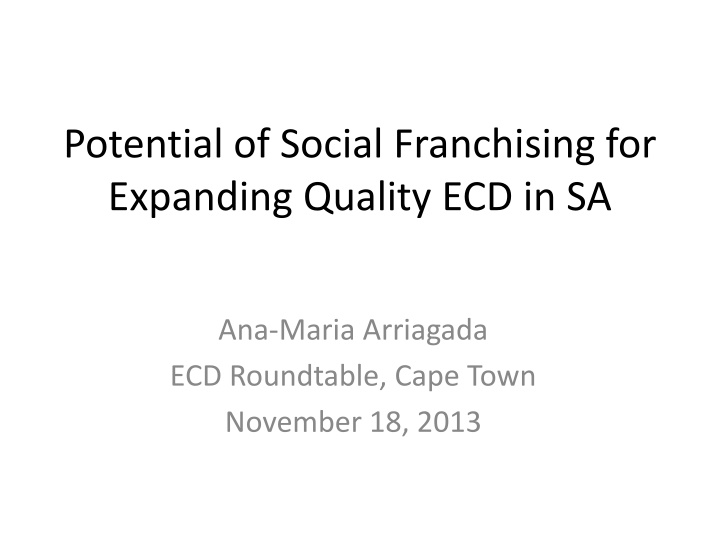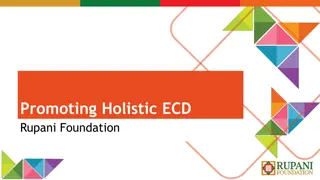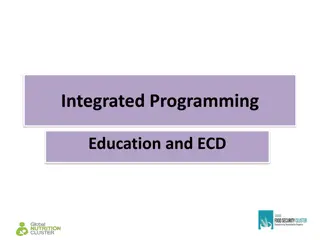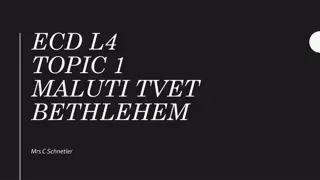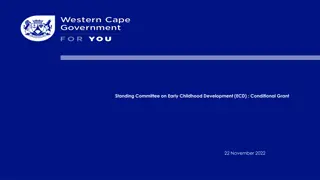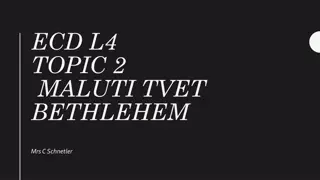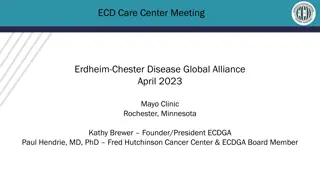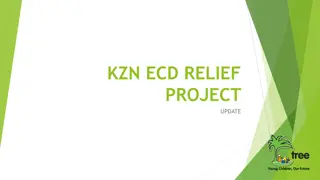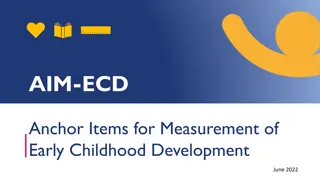Potential of Social Franchising for Expanding Quality ECD in SA
Addressing the significance of social franchising in extending Early Childhood Development (ECD) services in South Africa, emphasizing the challenges and opportunities within the current landscape. Insights on ECD interventions, research findings, and policy advancements driving progress in ECD expansion to enhance child development outcomes.
Download Presentation

Please find below an Image/Link to download the presentation.
The content on the website is provided AS IS for your information and personal use only. It may not be sold, licensed, or shared on other websites without obtaining consent from the author.If you encounter any issues during the download, it is possible that the publisher has removed the file from their server.
You are allowed to download the files provided on this website for personal or commercial use, subject to the condition that they are used lawfully. All files are the property of their respective owners.
The content on the website is provided AS IS for your information and personal use only. It may not be sold, licensed, or shared on other websites without obtaining consent from the author.
E N D
Presentation Transcript
Potential of Social Franchising for Expanding Quality ECD in SA Ana-Maria Arriagada ECD Roundtable, Cape Town November 18, 2013
Organization of this Presentation A. The Context: Why we care & where we are The ECD framework The state of play in ECD in SA Main challenge: scaling-up with quality B. An Option: A Social Franchise Approach What is a SF approach Potential advantages & disadvantages Common concerns
What is ECD & why it matters ECD = interventions to ensure children develop to potential in several domains: Physical (health & nutrition) Cognitive Language Socio-emotional
International Research Shows: The Accident of Birth Matters . Children from poor households show significantly worse outcomes early on Variance in development & cognitive abilities is strongly affected by genetics and by the environment High risk factors are more concentrated among the poor & less educated parents: demand constraints (lack of income, information failures, lack of knowledge) supply constraints (unequal distribution & quality of child services)
Poorest Children Arrive @ School w/Significant Disadvantages Ex. Ecuador Source: WB, Paxson & Schady, 2007
In SA, Significant Progress to Date: Progress in policy & regulatory environment since 1994 Government led expansion of grade R (5 year olds): Grade R enrollment from 40% in 2005 to 80% in 2011 Strong demand for child care services by low-income families, who pay fees for these services: > 19,000 registered ECD centers (>800,00 children) > Unknown # of unregistered providers (unknown # of children) Pre-grade R, de facto Public-Private partnership where: Government supports ECD by subsidizing participation (>400,000 children in registered ECD centers) ECD services are delivered by non-government providers (mainly non-profits) Significant body of experience/programs (albeit small scale) & research on what works in SA
Main Challenges Going Forward Challenge 1: ECD Scaling up is essential huge coverage gap Estimated 4 million 0-4 year olds, of which 2.32 million (58%) live in poverty. Only 20% of poor 0-4 year olds (464,000) receive some ECD service (unknown quantity & quality) . Hence, we have over 1.8 million poor 0-4 year olds w/o any ECD support. Note that coverage of non-poor 0-4 year olds is also low (44%) Supply of ECD highly uneven across the country with national averages masking large inter & intra-province differences in coverage
Challenge 2: ECD services must be of quality to have impact: - High variability in ECD services (from purely custodial care to world-class ECD) Idiosyncratic bundle of services (high variability) Tens of thousands of mostly stand-alone non-government providers Level of ECD fees is closely related to services received Quality of existing ECD services is uneven and probably low on average Unskilled practitioners (limited education & training, high turnover) Poor children receive lower quality services (because their families can pay less) Support from RTOs limited to a minority of ECD providers & uneven across the country
Challenge 3: Addressing sparse scaffolding for scaled up delivery of ECD Government: fragmented institutional arrangements Several sectors & levels of government involved in ECD (but unclear leadership & governance) Inconsistencies, cumbersome processes & procedures (DoH, DoE, DSD, DoHA, etc.) Insufficient operational/technical guidance & support for non-government ECD providers Disconnect between policy & regulations & implementation on the ground: Limited Government capacity to enforce policies & standards (key strategic gaps: ECD quality assurance & provider training) Limited Government & RTO capacity to support ECD service providers Poor communities unable to meet standards (example: infrastructure) Although government financing has increased overtime there are public financing issues: Insufficient funding to cover all poor 0-4 year olds Discretionary budget rules x provinces & municipalities (equitable share) Funding models used hinder participation of poorest & youngest
Challenge 4: Household constraints --need is not the same as demand : Poorer households have limited ability to pay for ECD services Insufficient awareness of critical importance of ECD x children s development (as distinct from child-minding) Lack of ECD services in poorest/most isolated areas Difficulty for caregivers to distinguish quality of services in ECD
How to manage a Quality ECD Scale up? Pulling together service provision by: 1. Standardizing ECD offerings and delivery: package of services based on outcomes to be achieved common key delivery systems & processes: training and materials service delivery mentoring of service providers (supervision) 2. Having a common quality assurance systems: indicators (inputs, intermediate outputs, outcomes (?) on-going monitoring periodic reporting Establishing a common M & E system: enables aggregation & strategic analysis enables benchmarking
What are the likely benefits of pulling together ECD provision? Attractive proposition for donors & government: Consistent offering Common metrics A quality assurance scheme Rapid expansion Increased and diversified service providers in ECD
Strategy Paths for Growth & Replication Growth and replication strategies Dissemination Partnership Licensing Joint ventures Wholly owned Social franchising Control Flexibility Colaboration Coordination Cooperation
What is Franchising? Franchising is a mechanism long used by commercial sector to enable rapid expansion in distribution of products/services of a specified quality (or standard) & reach scale through replication Franchisor (has a successful Model/package) Franchisee (sell to clients) Franchisee (sells to clients) Franchisee (sells to clients) Note: replication is not copying. It entails replicating ideas & approaches that are successful in one place to another in a manner appropriate for a given context
What is Social Franchising (SF)? A way to replicate a proven model to increase social impact through a formal agreement between a central unit (franchisor) and decentralized independent units (franchisees). Social benefit (not profit) is the main objective of a SF There is a proven prototype or standard package of goods, services & processes to be delivered Types of SF: Full/whole SF (only provides franchise standard package) Fractional SF (provides franchise standard package in addition to goods & services currently provided)
Financial sustainability in SFs Financial sustainability = coverage of operating costs (for franchisor & franchisees) Financing options: Self- financing: clients/users pay full cost of SF goods/services. Ex: low-cost private schools such as Bridge Academies (Kenya), Omega Schools (Ghana) Subsidized: government &/or donors pay fully/partially for the cost of SF goods/services delivered to beneficiaries. Ex: many reproductive health & family planning SFs (Mexico, Philippines, Pakistan, Zambia, India, Nicaragua) Diversified funding: user/client fees, governments, donors, interest income, etc. A SF network can achieve significant economies of scale through common systems & business processes: Drive unit costs down (for a given package of goods/services) Enhance cost-efficiencies
Basic components/elements of a SF: A social franchisor/organization with a proven or prototype business model (package of goods/services, systems and processes to deliver it) At least one independent social franchisee that delivers the prototype business model in a given area A documented agreement that binds them together spelling out responsibilities for each party A brand name for the program/package Systematic training for the delivery of the business model (content & processes) Systematic & standardized methods of appraisal and quality assurance measures (mentoring & supervision) An ongoing exchange of knowledge/information between the SF members
Advantages & Disadvantages of a Franchise Model Advantages Disadvantages x Franchisor: rapid expansion increase promotion of brand increase social impact create network of local organizations additional revenue streams low-risk expansion x Franchisor: time & resources to systematize, build toolkits x franchisees & training resources needed & difficulties to continuously monitor & support franchisees (quality & accountability) time & resources to select the right franchisees x Franchisee: safer investment (proven prototype) training & support from franchisor benefit from brand promotion network to share ideas with easier to mobilize resources reduce competition from peers x Franchisee: risk of autonomy/identity loss risk of negative reputation (if other franchisees do not deliver on quality) willingness to be monitored (on quality & accountability)
A SF Business Model in Education: Low-Cost Schooling in Kenya & Ghana Grant Making Organizations Quality Assurance, Support & Accountability Social Franchiser Franchisees (standardized services) (seed $, expertise, & technology) Income (Fee) Investors (loans) * Kenya Bridge Academies and Ghana Omega Schools
SF Business Model w/Subsidies (Some Reproductive Health & Family Planning SFs) Grant Making Organizations Quality Assurance, Support & Accountability Social Franchiser Franchisees (standardized services) (seed $, expertise, commodities & technology) Data &/or Income Government subsidies to SF Government subsidies to beneficiaries (CCT, vouchers)
A SF Business Model w/field offices for supervision & support Social Franchisor (seed $, expertise, & technology) Filed Office Franchisee (Area 1) Field Office Franchisee (Area 3) Field Office Franchisee (Area 2) service delivery
Potential of a SF model to scale-up quality ECD (cont.) A Standard ECD Package would contribute to: Create consistency in ECD services, facilitate awareness raising about ECD, branding & recognition Facilitate design & development of training for low skilled providers/practitioners, training materials, on-going support systems Facilitate development of service delivery indicators & enable benchmarking based on actuals Enable future expansion of services via replication by different providers (not only in the ECD sector such as health & nutrition and child care organizations) Concerns with standardization of ECD package: A "prescriptive" approach to ECD services delivery is seen as inappropriate Standard package concept seen as a one-size-fits-all, cookie-cutter Competing views on what should be in the "essential package My organizations runs well organized and systematized programs with proven impact, why should I change? Likely tension between an ideal package of ECD services, availability of resources, and affordability (trade-off needed)
Concerns with a SF model for ECD Scaling-up ECD seen as Government s job Use of commercial business tools in the non-profit sector represents a paradigm shift Replication seen as copying or duplicating without taking local peculiarities into account Systematic quality assurance & M&E would be too expensive Bureaucratic & complicated processes Loss of autonomy & identity/changing own mission What would be the role of ECD RTOs in an ECD SF? Weak potential players to take franchisee role Note: This is a preliminary list of concerns
Potential of a SF model to scale-up quality ECD Networking isolated providers could raise organizational capacity in core competences: Franchisor training, quality assurance, implementation support, M&E (monitoring, reporting, evaluation) Franchisee manage delivery of a standard ECD package & community/local relationships Common schemes & business processes could enhance scaffolding for ECD scale-up: Awareness raising & promotion of ECD Systematic training and support to ECD providers Systematic monitoring, reporting & evaluation Mobilizing & leveraging resources for ECD (negotiating with government, contracting, bulk procurement, etc.) Common schemes & business processes could facilitate targeting on population basis. Today s IT internet based technology would greatly facilitate quality scale- up Common schemes & business Processes would enable use of innovative financing mechanisms standard package + solid monitoring (such as results-based-financing, RBF)
